|
|
 The
Carmel River mouth lagoon is a favored birding spot, including the lagoon
at Carmel River State Beach, and the 'new' Odello 'arms' in the wetland
restoration project. The entire Carmel River mouth vicinity is one of the
top birding spots in California; I have a set
of pages about birding here. The
Carmel River mouth lagoon is a favored birding spot, including the lagoon
at Carmel River State Beach, and the 'new' Odello 'arms' in the wetland
restoration project. The entire Carmel River mouth vicinity is one of the
top birding spots in California; I have a set
of pages about birding here.
The sunny but breezy afternoon of 7 July 2006 was much like any other
birding walk — interesting birds were about, including a male Ruddy
Duck going through a full courtship display with rapid head bobbing
and tipped-up tail (right).
But this walk was a little different — for the first ever here, Rita
and I were looking for dragonflies (in addition to birds). Somewhat amazingly,
there was a fine variety of odes to be seen: |
| We first encountered several large tomato-colored dragons patrolling
stretches of the weedy, and tick-laden, path. They were constantly in motion
and it took all of my patience to wait until it alighted. Using Manolis
(2003), we've identified it as Wandering Glider Pantala
flavescens. The chestnut-red eyes are cool; so are the deep blue spots
atop the end of the abdomen. It is a true wanderer, and occurs almost worldwide,
including the middle of the Pacific Ocean (e.g., Hawaii). |
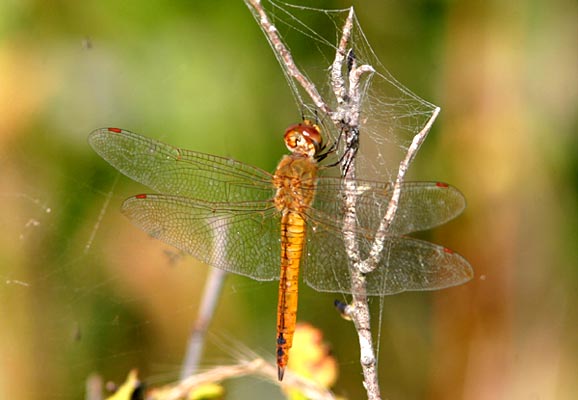 |
|
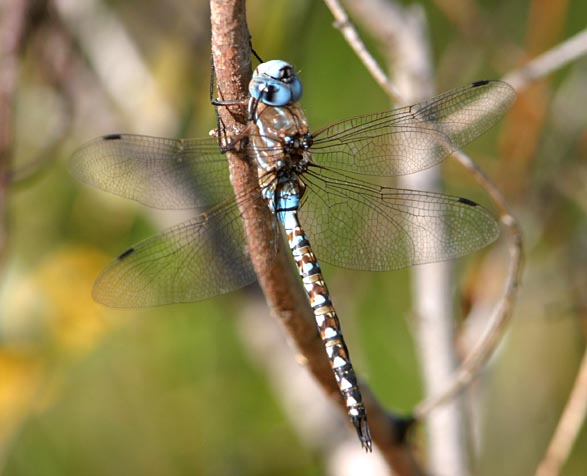 |
Another large and impressive dragon — it also patrolled a route and
spent 90% of its time in the air — was Blue-eyed Darner Rhionaeschna
multicolor. It was a 3" wingspan and looks very sturdy. It is a widespread
species in western North America, ranging from sea-level (here) to over
7000' elevation. This is a male with blue 'racing stripes' on the thorax. |
|
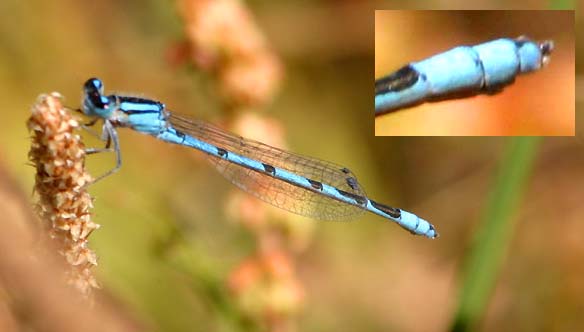 Of
course, many odonates are very small, especially the damselflies. Unlike
dragonflies, which hold their wings out when perched, most of the damselflies
hold their wings in next to their body when perched. Of
course, many odonates are very small, especially the damselflies. Unlike
dragonflies, which hold their wings out when perched, most of the damselflies
hold their wings in next to their body when perched.
This one (right) keyed out to Familiar Bluet Enallagma
civile, based upon the relative amounts of blue versus black on the
abdomen and details of the male's apparatus at the tip of the abdomen (inset):
a broad, rounded cerci (the upper of the two final appendages) with a pale
tip. There are 35 bluets north of Mexico and 8 in California (Manolis 2003).
They are only one inch long, so this photo is about 5X life size. It is
very easy to overlook bluets (and other damsels) unless you are looking
for them. Males bluets are blue-and-black but females and young males are
dark-and-tan and very difficult to identify. |
| There was plenty of sex going on in the marsh. Most odonates lay eggs
in the water so many species search for mates at the water edge discos.
If you don't know anything about dragonfly sex — and I didn't until reading
Manolis (2003) — I thought that flying in tandem was the mating act. It
is not. Rather, copulation is complex. The male has specially designed
hooks and graspers at the tip of his abdomen, and he grabs the female just
behind the head or thorax. The female then bends her abdomen forward to
bring her reproductive organs to the male's secondary genitalia, housed
on his second (of ten) abdominal segments. So they have two points of linkage,
and this position is called "the wheel" (below). They may hold this
position for a few minutes to an hour, depending on species. [Is this in
your Kama Sutra?] |
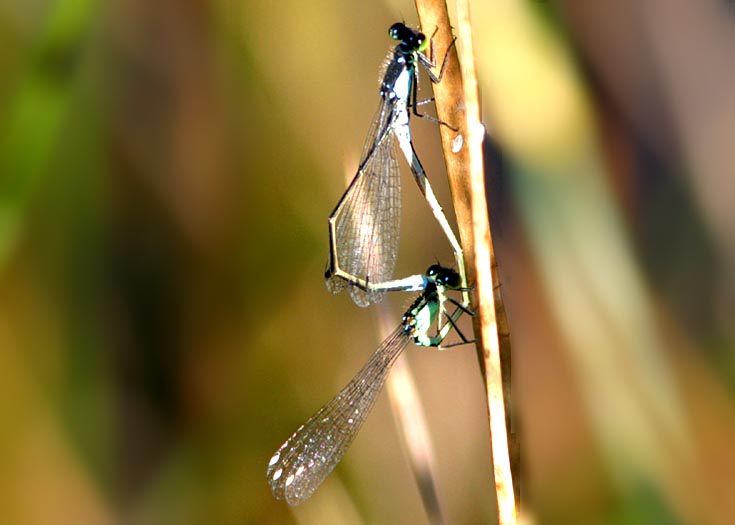
| The damselflies "in wheel" (above) are a pair of Pacific ForktailIschnura
cervula. They are only an inch long, so this view is much larger than
life size. The female here (she's the lower one) is quite similar to the
male; this is a condition in which the female is called andromorphic. When
females look different than males, the condition is called gymnomorphic.
Females in both conditions can mate and lay eggs. The tiny turquoise spots
on the black-topped thorax are one important i.d. feature. Pacific Forktail
is common and widespread in California, and it ranges from southern Canada
to northern Mexico. |
|
| And after sex, what does a dragonfly do? No, they do not smoke a cigarette.
She lays eggs (just now fertilized), often with the male still "in tandem,"
grasping her by the neck or, in some species, hovering just overhead. Presumably
this allows him to assure that "his" eggs are safely laid without interference
by other males. The term for egg-laying is oviposition. During our little
walk, we lucked into a pair in oviposition (below). |
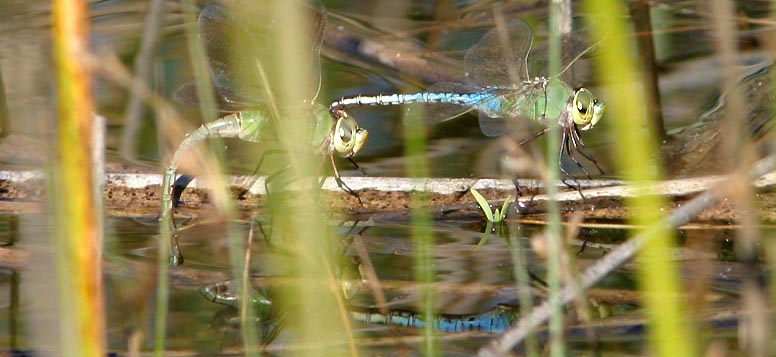
| The species that we spotted in oviposition (above) is one of the largest
of all dragonflies: Common Green Darner Anax junius.
It is up to 3" long with a wingspan of 4 inches. The males with green thorax
and blue abdomen spend almost all their time patrolling over ponds and
lakes, seemingly never landing (and apparently mostly doing so in the woods
away from the water). They are common and we've seen them almost every
time we've looked, but I despaired of getting a photo. It took this situation
— when he's hooked up with the all-green female — to get a shot (and it
even has a reflection!). Note that the female has dipped the tip of her
abdomen into the water to lay eggs. |
|
|
|
Literature cited:
Manolis, T. 2003. Dragonflies and Damselflies of California.
Calif. Natural Hist. Guide 72. Univ. of Calif., Berkeley, CA.
|
PHOTOS: All photos are © 2006 Don Roberson; all rights
reserved.
TOP
TO PORTAL
PAGE OF DON'S ODONates
TO LIST OF BIRD
FAMILIES OF THE WORLD
TO MONTEREY COUNTY
PAGE
TO HOME PAGE
|